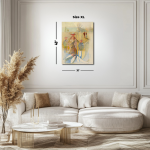Layers of Time: The Stroll Through Memory
This conceptual reimagining of Monet’s The Stroll at Giverny (1880s) transforms a peaceful moment into a layered meditation on time and memory. The original figures appear twice, their ghostly reflections dissolving into abstraction, suggesting that moments do not vanish but instead echo through time. A windmill emerges, its blades merging with faint clockwork, symbolizing the ceaseless passage of time. The soft, impressionistic hues of Monet’s landscape remain but are now interrupted by geometric elements and muted grays, creating a dialogue between the past and modern perception. This piece reinterprets a simple walk as a journey through memory, where time does not move forward but rather folds, overlaps, and imprints itself onto every passing moment.
Please see Below for Details…
Hotline Order:
Mon - Fri: 07AM - 06PM
404-872-4663
Claude Monet’s The Stroll at Giverny , painted in the late 1880s, captured an intimate moment of leisure in the golden fields surrounding his home. The soft impressionist strokes rendered a world where light and color blended seamlessly, portraying the fleeting nature of time spent with loved ones. The figures—perhaps Camille Monet or another close family member—stand in a moment of pause, their presence both firm and ephemeral, much like the light that bathes the landscape.
In this conceptual collage reimagining, the past does not remain static. The figures of the original painting become layered with abstract mechanical elements, ghostly repetitions, and a fragmented interplay of light and shadow. The mother and her children appear twice—once in their original soft-hued presence, and again as distorted reflections, as if caught between time periods, their outlines blending into the surrounding abstraction. Their overlapping forms suggest that memory does not exist in a linear sequence but rather in layered echoes, where one moment reverberates across time.
A windmill, previously absent, emerges in the composition, its blades dissolving into the golden haze. The windmill becomes both a symbol of movement and a reminder of time’s passing, an ever-turning force that dictates the cycle of days. The suggestion of a clock faintly appears in the background, reinforcing the concept that every stroll, every glance, every simple moment spent in nature is measured and absorbed by time itself.
The palette remains true to Monet’s love for warmth—soft yellows, subdued blues, and earthy greens create a sense of nostalgia. However, muted mechanical grays and geometric segments begin to filter through, as if the painting itself is being dissected and reassembled. The brushstrokes of impressionism meet the calculated precision of modern abstraction, creating a tension between organic memory and structured perception.
As an artist, my intention was to bridge the gap between past and present, between the natural and the constructed. Monet’s original work celebrated the fleeting nature of life, and in this reinterpretation, that same fleeting quality is heightened through fragmentation. The figures remain in the landscape, but they are now echoes of themselves, existing simultaneously in multiple realities. They are moving forward yet remain tethered to the past, much like the way memory holds onto moments long after they have passed.
This composition explores the ways in which time imprints itself onto experience. The figures are no longer simply walking through a field; they are walking through layers of recollection, through moments suspended in the subconscious. The gentle motion of a summer stroll becomes something more profound—a reminder that even the simplest gestures become a part of time’s intricate weaving.
Add your review
Your email address will not be published. Required fields are marked *
Please login to write review!
Looks like there are no reviews yet.










